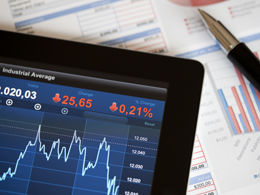Monthly Market Risk Update: April 2016
by Brad McMillan Commonwealth Financial Network
It’s time for our monthly look at market risk factors. Just as with the economy, there are several key factors that matter for the market, in determining both the risk level and the immediacy of the risk. Stocks have largely recovered from their recent pullback, but given valuations and recent market behavior, it will be useful to keep an eye on these factors.
Risk factor #1: Valuation levels
When it comes to assessing valuations, I find longer-term metrics, particularly the cyclically adjusted P/E ratio, which looks at average earnings over the past 10 years, to be the most useful.

Two things jump out here:
- First, valuations are approaching the levels of 2007–2008, which speaks for itself.
- Second, even at the bottom of the recent pullback, valuations were at levels above any point since before the crisis.
Although valuations are at close to peak levels for the past 10 years, they remain well below the 2000 peak, so you could argue that this metric isn’t suggesting high risk. Of course, that assumes we might head back to 2000 bubble conditions, which doesn't exactly mean risks are low.
Risk factor #2: Changes in valuation levels
Another way to use this data is to look at the changes in valuation levels over time as an indicator of trouble ahead.

Here, you can see that when valuations roll over, with the change dropping below zero over a 10-month or 200-day period, the market itself typically drops shortly thereafter. Despite the recent recovery, we're still seeing that kind of decline, so this is clearly an indicator of potential risk. The metric is recovering, however, which means the risk may be receding.
Risk factor #3: Margin debt
Another indicator of potential trouble is margin debt.

Here, we can see that, as a percentage of market capitalization, margin debt has moved up to an all-time high, above the level of 2000. This is certainly an indicator of higher risk, but again, not necessarily immediate risk.
Risk factor #4: Changes in margin debt
If we look at the change over time, however, even as the absolute risk level remains high, the immediate risk does not. We don’t yet see the kind of spike in debt that occurred just before previous pullbacks, although we are definitely moving in that direction.

This risk trigger isn’t being pulled just yet, but it may be soon enough.
Risk factor #5: The Buffett indicator
Said to be favored by Warren Buffett, the final indicator is the ratio of the value of all the companies in the market to the national economy as a whole.

On an absolute basis, this indicator is actually somewhat encouraging. Although it remains high, it has pulled back to less extreme levels. On a change-over-time basis, however, downturns in this indicator have typically led market pullbacks—and once again, we see that here.
Amid recovery, keeping an eye on the risks
Despite a substantial recovery in stock prices, risks are clearly still apparent. Technicals are another worrying factor; although improving, the market remains below its long-term (i.e., 400-day) trend line. Per these indicators, risk levels could very well rise.
There’s a big difference, however, between high risk and immediate risk—and it is one that is crucial to investing. Not all of the indicators suggest an immediate problem, and the market recovery may continue, even as the risks remain for the future.
As I said last time, I will continue to think about which factors to highlight here, with an emphasis on signals that may suggest the risk is more immediate and severe. I’d welcome your suggestions!
Commonwealth Financial Network is the nation’s largest privately held independent broker/dealer-RIA. This post originally appeared on Commonwealth Independent Advisor, the firm’s corporate blog.
Copyright © Commonwealth Financial Network













